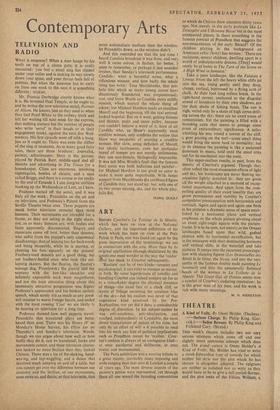TELEVISION AND RADIO
WHAT is suspense? When a man hangs by his teeth on top of a circus pole, it is easily measured : you feel a small slug has slipped under your collar and is making its way slowly down your spine, and your throat feels full of pebbles. But when the suspense has to carry on from one week to the next it is something different : trickier.
Mr. Francis Durbridge clearly knows what it is. He invented Paul Temple, so he ought to, and he writes the new television serial, Portrait of Alison. He knows, just as they used to when they tied Pearl White to the railway track and left her waiting till next week for the express, that nothing matters but the number of people who write 'serial' in their heads or in their engagement books, against the next five Wed- nesdays. His first episode went off with a bang. just as it ought to. There was even the slither of the slug at moments. As in many good fairy tales, there are three brothers : journalist, painter, schoolmaster. Hero is the painter, played by Patrick Barr, middle-aged and all thumbs and advertising in The Times for a housekeeper. Clues are enormous, involving nightingales, bottles of chianti, and a man called Briggs, and there is a corpse in the studio by the end of Episode I. I can imagine millions booking up the Wednesdays of Lent, as I have.
Positano started off the serial, and it was Italy all the week Pirandello on the air and on television, and Podrecca's Piecoli from the Saville Theatre twice over. These puppets are much better television material than most humans. Their movements are intended for a frame, so they are acting in the right shape, not, as so many humans arc, with bodies and faces apparently disconnected. Singers and musicians come off best, better than dancers. who suffer from the puppet's only anatomical disadvantage, that of leaning too far backwards and being incapable, while he is moving, of planting his feet. squarely on the ground. Feathery-toed dancers are a good thing, but not feathery-heeled ones, who look like col- lapsing skaters. But the flautist, the flautist's sausage dog. Piccolowsky the pianist and the soprano with the hen-like chuckles and infinitely expansible neck were magnificent; and not the least attractive thing about this more nationalistic medium than the wireless. let Pirandello down, as the wireless didn't.
And this reminded me that the last time I heard Candida broadcast it was done, and very well it came across, in Italian; far better, 1 seem to remember, or perhaps it just sounded fresher, than Sunday's television performance. Candida : what a beautiful name, what a ridiculous woman, and how badly the whole thing has worn ! True Marchbanks, that pot- hole into which so many young actors have disastrously floundered, was preposterously cast, and Irene Worth as Candida more mildly miscast, which started the whole thing on askew; but Michael Hordcrn made an excellent Morell and the beginning. till the taxi arrived, looked hopeful. But on it went, getting thinner and thinner, paler and more paltry, because you couldn't believe a word of it, least of all Candida who, as Shaw's supposedly most credible woman, only confirms the notion that Shaw was incapable of creating a credible woman. Her slow, smug deflation of Morell, her idiotic tactlessness, even her particular brand of temper are not merely unfeminine, they are non-female, biologically impossible. It was not Miss Worth's fault that the famous final scene was both ludicrous and painful— for Michael Hordcrn is too good an actor to make it seem quite improbable. With better support from Marchbanks the cardboard figure of Candida may just stand up: but, with one of its two props missing, she, and the whole play,. falls flat.
ISABEL QUIGLY










































 Previous page
Previous page